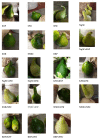Morpho-Agronomic Evaluation of Lagenaria siceraria Landraces and Their F1 Populations
- PMID: 35736709
- PMCID: PMC9229447
- DOI: 10.3390/plants11121558
Morpho-Agronomic Evaluation of Lagenaria siceraria Landraces and Their F1 Populations
Abstract
Lagenaria siceraria is one of the most important cucurbitaceous vegetables due to its prolific bearing habit, its edibility as a cooked vegetable, and its low cost of cultivation. The objective of this study was to evaluate variation in the morpho-agronomic traits among selected landraces and their F1 populations. The landraces were crossed based on the North Carolina II genetic design to develop F1 populations. The twelve F1 populations along with seven parental landraces were grown in a randomized complete block design with three replications. Significant differences (p < 0.05) were observed among quantitative traits suggesting considerable genetic variability. The genotypes displayed significant variation in most qualitative traits of fruits and seeds. The first five principal components of quantitative traits among the evaluated 19 genotypes contributed 74.84% of the variability. The biplot and dendrogram clustered the genotypes into five clusters according to their vegetative, fruit, and seed traits. The highest value for the broad-sense heritability estimate was recorded for days to edible harvest maturity trait. The F1 progenies were more variable than the landraces and can therefore be used for further Lagenaria siceraria genetic improvement.
Keywords: F1; fruit; genetic variability; genotypes; leaf; qualitative; quantitative traits; shape; yield.
Conflict of interest statement
The authors declare no conflict of interest.
Figures





References
-
- Doloi N., Patel J.N., Acharya R.R. Heterosis Studies in Bottle Gourd [Lagenaria siceraria (Mol) Standl.] Vegetos. 2018;31:253–256.
-
- Mladenović E., Berenji J., Ognjanov V., Ljubojević M., Cukanović J. Genetic variability of bottle gourd Lagenaria siceraria (Mol.) standley and its morphological characterization by multivariate analysis. Arch. Biol. Sci. Belgrade. 2012;64:573–583. doi: 10.2298/ABS1202573M. - DOI
-
- Yetisir H., Sakar M., Serce S. Collection and morphological characterization of Lagenaria siceraria germplasm from the Mediterranean region of Turkey. Genet. Resour. Crop Evol. 2008;55:1257–1266. doi: 10.1007/s10722-008-9325-y. - DOI
-
- Keneni G., Jarso M., Wolabu T., Dino G. Extent and pattern of genetic diversity for morpho-agronomic traits in Ethiopian highland pulse landraces II. Faba bean (Vicia faba L.) Genet. Resour. Crop Evol. 2005;52:551–561. doi: 10.1007/s10722-003-6022-8. - DOI
LinkOut - more resources
Full Text Sources

